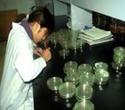Germs(细菌) are everywhere. You can’t see them, but they are on your desk, on your computer, and even in the air! Like people, germs move around the world. They fly with us on planes. When food, clothes, and other things travel around the world, germs travel, too. Some germs are safe, but some are dangerous. Germs cause illnesses like colds and the flu.

Warmer Weather Brings Germs
The world’s weather is changing. Cooler countries are getting warmer, so insects from hot countries can move there. Some of these insects, like mosquitoes, carry dangerous germs. These germs cause headaches, fever, and can even kill people.
Under Your Skin
Your skin protects you from germs. It stops some germs, but not all. They can enter your body when you eat, or when you have a cut. Germs are on your hands, too. They enter your body when you touch your eyes, nose, or mouth.
Fighting Germs
Your immune system protects you, too. When germs get inside your body, your immune system finds and kills them. Special cells(细胞) move around your body and fight germs. They help you stay healthy. Other cells make antibodies. Antibodies help your body find and stop germs. What can you do to fight germs? You should wash your hands with soap and water. Soap kills many germs, and water washes them away.
小题1:According to the passage, insects .
A.kill germs
B.carry germs
C.protect germs
D.love germs小题2:The underlined word “there” refers to .
A.cooler countries
B.hot countries
C.everywhere
D.the world小题3:Which of the following is right according to the passage?
A.All germs are dangerous
B.There are more germs in cold places
C.Soup can kill all germs
D.Germs can get into your body小题4:What does the word “immune” mean in Chinese in the last paregraph?
A.消化
B.神经
C.免疫
D.分泌小题5:What’s the main idea of this passage?
A.Germ are everywhere
B.Weather in Changing
C.Skin stops germs
D.Germs are developed